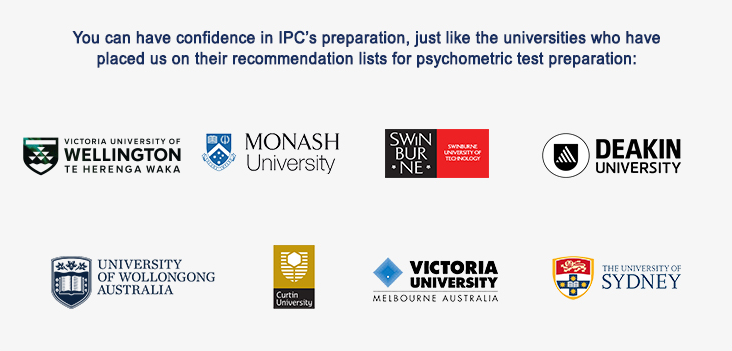Prepare for Saville Consulting tests - practice Saville aptitude test and the Wave personality test, online Saville test courses and 1-on-1 coaching
Find out how the Institute of Psychometric Coaching effectively prepares you through tailored practice tests, online courses and personal coaching for your psychometric, aptitude and personality tests developed by Saville Consulting.
About Saville Consulting
Saville Consulting was founded by Peter Saville in the UK in 2004. Peter is one of the founders of SHL Group. Saville Consulting is an industry leader in the UK and in 2005 opened up in Australia. Their strong reputation is rapidly becoming well-known across the globe.
Saville’s Cognitive or Aptitude Tests
Saville Consulting offers two types of Aptitude Tests:
The Swift Executive Aptitude Test
This test is typically offered to job applicants applying for managerial or professional roles. The Swift Executive Test includes 3 consecutive sub sections measuring 3 components of analytical analysis:
- Part 1 - Verbal Analysis (or reasoning) - this section measures your verbal reasoning skills. Test questions include paragraphs of information, following by statements and questions relating to the paragraph. Your task is to accurately answer each question or statement based on the information provided in the paragraphs.
Let's review the following verbal analysis example question:
In epistemology, the Munchausen trilemma is a thought experiment used to demonstrate the impossibility of proving any truth, even in the fields of logic and mathematics. If it is asked how any knowledge is known to be true, proof may be provided. Yet that same question can be asked of the proof, and any subsequent proof. The Munchausen trilemma is that there are only three options when providing proof in this situation: (a) the circular argument, in which theory and proof support each other; (b) the regressive argument, in which each proof requires a further proof, ad infinitum; and (c) the axiomatic argument, which rests on accepted precepts. The trilemma, then, is the decision among the three equally unsatisfying options.
The name Munchausen Trilemma was coined in 1968 by the German philosopher Hans Albert in reference to a trilemma of “dogmatism versus infinite regress versus psychologism” used by Karl Popper. It is a reference to the problem of ‘bootstrapping’, based on the story of Baron Munchausen pulling himself and the horse on which he was sitting out of a mire by his own hair.
Based on the passage, wwhich one of the following does NOT follow based on the content of the text?
a. Karl Popper was a German philosopher.
b. There are three argument options when providing proof of whether any knowledge is true.
c. The axiomatic argument is one which rests on accepted precepts.
d. When each proof requires further proof ad infinitum, it is called a regressive argument.
e. Baron Munchausen rode a horse.
To answer this style of test questions you need to read the passage to find the correct answer. Nowhere in the text does it mention Karl Popper’s origins. The text only says that Hans Albert was a German philosopher. Therefore, the correct answer is that Karl Popper was a German philosopher.
- Part 2 - Numerical Analysis (or reasoning) - this section measures your numerical reasoning skills. The test doesn’t measure your skills in maths but your ability to quickly and logically process numerical information. Test questions include interpretations of numerical data displayed as graphs and tables.
In this example of a Saville type numerical test question, you are asked a question based on the information presented.

What is the ratio of the differences in actual sales to target sales in Thailand and Italy during the fourth quarter?
To answer this test numerical aptitude question, we need to review the information provided in the table. According to the table, Thailand’s fourth-quarter sales target was 550, but actual sales were: 205 + 105 + 260 = 570. This is a difference of 20 (570 – 550). Italy’s target was 600 sales, but actual sales were: 125 + 250 + 240 = 615. The difference here was 15 (615 – 600). Therefore, the Thailand to Italy ratio of differences is 20:15 = 4:3.
- Part 3 - Abstract Analysis (or reasoning) – this section measures your conceptual reasoning skills. The test includes scenarios, each scenario includes a group of shapes with some logical rules. You need to identify a logical sequence to decide which is the next shape or the odd one out.
Let's review the following example of a Saville type abstract test question. This abstract aptitude test question demonstrates one style of abstract aptitude test questions in which you have a horizontal list of shapes and your task is to identify the patterns or logical rules for the set of shapes to be able to predict the next or missing shape.
 What is the next shape?
What is the next shape?
To answer this abstract, logical and inductive aptitude and reasoning test question, we need to first identify the patterns and logical rules among the group of shapes in the test question. In this set of shapes, we can identify two logical rules or patterns moving left to right. The first is that all the inner shapes move one place anticlockwise each step. The second rule is that, at every step, the triangle alternates with a black square. At step five, there is a triangle at the top – therefore, at the next step, it will move anticlockwise into the left place and become a black square.

- Part 4 - Diagrammatic test - this section measures your ability to understand logical processes. Each question has a set of input and output figures and a number of operators/effects. The operations/effects' function is described in text and in illustrations. In each question there is one element missing - either the input figures or output figures or the operations.
Let's review the following example of a Saville diagrammatic test question:

The question is:

This question requires you to identify the correct sequence of ‘input’ shapes based on the provided sequence of ‘output’ shapes. For this style of question, you are not provided the input sequence, rather, only the output sequence and an “Effect Operator”. These operators modify the input shapes in different ways to transform them into the output result. To solve this task, you must work backwards starting with the output sequence with reference to the operator and applying the effect in reverse to identify the correct input sequence.
In this question there is only one operator or effect. Based on the illustrated instruction panel, effect * changes the shapes and sizes of all white figures (from squares to circles or from circles to squares and from big to small or small to big). To reverse this effect, we need to change back all the white figures’ shapes and sizes. This means changing the first small, white square into a big, white circle and changing the second figure, which is a big, white circle into a small, white square. The sequence of figures after reversing this effect is: a big, white circle, followed by a small, white square and a small, black circle.
The Swift Analysis Test allows candidates 18 minutes to complete the entire test (6 minutes for each section as described above.
The Comprehension Aptitude Test
This test is typically offered to job applicants applying for non-managerial, operations or admin roles. The Comprehension Aptitude Test includes 3 consecutive sub sections measuring 3 components of reasoning:
- Part 1 - Verbal Analysis (or reasoning) - this section measures your verbal reasoning skills. Test questions include paragraphs of information, following by statements and questions relating to the paragraph. Your task is to accurately answer each question or statement based on the information provided in the paragraphs.
- Part 2 - Numerical Analysis (or reasoning) - this section measures your numerical reasoning skills. The test doesn’t measure your skills in maths but your ability to quickly and logically process numerical information. Test questions include interpretations of numerical data displayed as graphs and tables.
- Part 3 Error Checking - this test measures your attention to details. The test includes several scenarios with lists of words and numbers. Your task is to identify errors in the lists of words and numbers.
The Comprehension Test allows candidates 10 minutes to complete the entire test (4 min to complete the Verbal Comprehension section, 4 min to complete the Numerical Comprehension section and 2 min to complete the Error Checking section).
Saville’s Personality Test
Saville Consulting developed the “Wave Personality Test”. The Wave has 108 items and is used by employers to assess job candidates’ behavioural style.
The Wave Personality Test includes normative and ipsative sections:
The normative section, presents behavioural statements which candidates need to express the extent of their agreement or disagreement on a scale of 1 to 5. For example, “My daily life is full of things that keep me interested”.
The ipsative section includes quads (as questions). Each quad contains 4 statements from which an individual is required to choose two. One that is most like them and one that is least like them. The ipsative aspect of this personality test uses a forced choice format where candidates have to choose two statements from a quad of equally attractive statements.
For example, please state which is the most and least like you:
- I enjoy working with others
- I like to plan and organise my work
- I enjoy meeting people
- I respect and open to others’ opinions
The Wave personality test is untimed.
Which companies use Saville Consulting’s Aptitude and Personality Tests?
Saville Consulting’s set of aptitude and personality tests is used by a wide range of companies such as: Johnson & Johnson, NAB, Westpack, ANZ and Ramsted, amongst many others.
Please note that most companies tend to have more than one psychometric test provider.
Practise and preparation for your Psychometric Test with Saville Consulting
The Institute of Psychometric Coaching offer job-seekers the best available opportunity to practise and prepare for psychometric tests to get the job they really want. IPC offers online and tailored practise tests and preparation solutions developed by Saville:
- Practise online tests mimicking the verbal, numerical and abstract test questions in Saville’s Swift Executive and Comprehension Aptitude Tests
- Practise online Personality Tests to prepare you for the Wave personality test
- Fully tailored online cognitive and personality test courses
- One-on-one coaching sessions delivered by experienced psychologists and psychometric test trainers
Try our practise online tests and preparation solutions for your Saville Consulting’s Aptitude and Personality tests to ensure you demonstrate your true capability.
Saville, WAVE, Swift and other trademarks are the property of their trademark holders. None of the trademark holders are affiliated with the Institute of Psychometric Coaching or this site.









